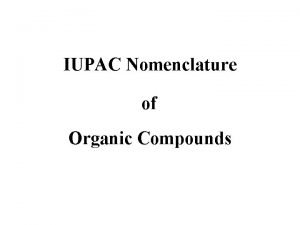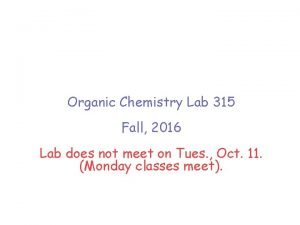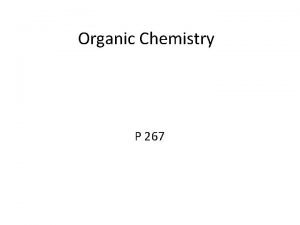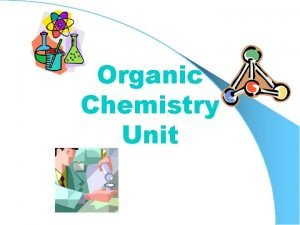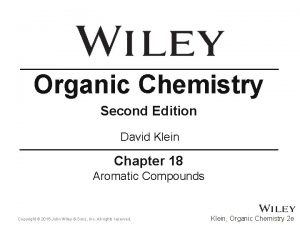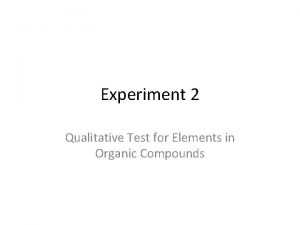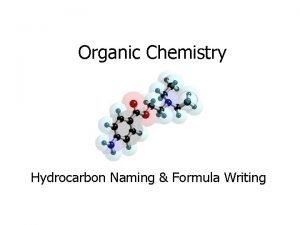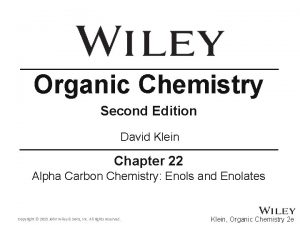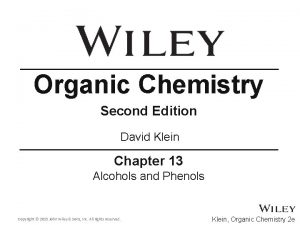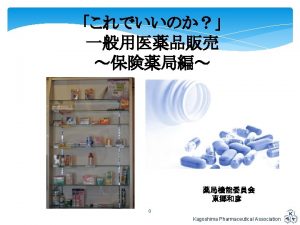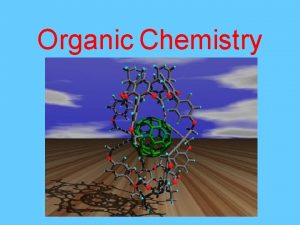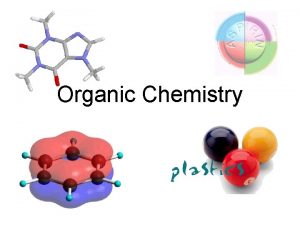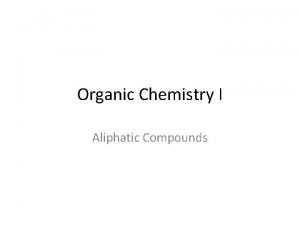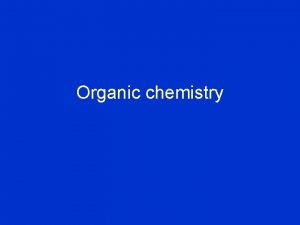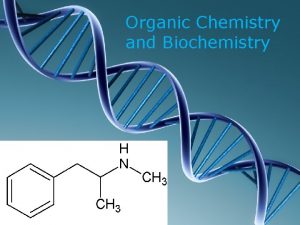Organic pharmaceutical chemistry Organic chemistry Organic chemistry is























- Slides: 23

Organic pharmaceutical chemistry

Organic chemistry: Organic chemistry is the scientific study of the structure, properties, composition, reactions, and synthesis of organic compounds (molecules composed of carbon, hydrogen, and may contain any number of other elements like nitrogen, oxygen and halogens).

Organic pharmaceutical chemistry is the study of drugs, and it involves drug development. This includes drug discovery, delivery, absorption, metabolism, and more.

Aim of this lab: synthesis of known drugs like aspirin, phenytoin, paracetamol…etc, through a suitable reactions depending on drug’s molecular structure and the available chemicals and tools.

Chemical reactions Most molecules are at peace with themselves. Bottles of sulfuric acid, sodium hydroxide, water, or acetone can be safely stored in a laboratory cupboard for years without any change in the chemical composition of the molecules inside.

Reactions happen when electrons flow between molecules • When pair of molecules find themselves close together, a reaction can take place provided electrons move from one molecule to another. This is what we call the mechanism of the reaction (the detailed description of the pathway the electrons take). • The molecule that accepts the electrons is called the electrophile (electron-lover). • The molecule that donates the electrons is called the nucleophile.


Identifying a nucleophile • Neutral nucleophiles with lone pairs of electrons, typically: ammonia, amines, water, and alcohols, all of which have lone pairs (one for N, two of equal energy for O).

The arrow starts on the lone pair

• Negatively charged nucleophiles are often good nucleophiles too, partly because they can be attracted electrostatically by positively charged electrophiles. The anionic centre is usually O, S, or halogen. For example, hydroxide.

The arrow starts on the hydroxide’s negative charge, which represents one of the oxygen’s pairs of electrons

• Bonding π orbitals, especially C=C double bonds, since they are higher in energy than σ orbitals. The only common π nucleophiles are alkenes and aromatic rings.

Identifying an electrophile • Neutral electrophiles with an empty atomic orbital that can easily accept electrons, such as boron trifluoride and aluminium trichloride.


• Positively charged electrophile like carbonyl group. There is a partial positive charge on the carbon and a partial negative charge on the oxygen, because oxygen is more electronegative than carbon. So the oxygen pulls electrons towards itself.

Curly arrow A curly arrow represents the movement of a pair of electrons from a filled orbital into an empty orbital. The result of this movement is to form a bond between a nucleophile and an electrophile.

• Arrow to make new bond

• Arrow to break an old bond

Example Electrons flow from the nucleophile (NH 3) to the electrophile (BH 3) and a new bond is formed.

Chemistry Laboratory Safety Rules 1. Always Follow the Instructions. 2. Do Not Pipette by Mouth - Ever. 3. Read the Chemical Safety Information. A Material Safety Data Sheet (MSDS) should be available for every chemical you use in the lab. 4. Don't Taste or Sniff Chemicals 5. Dress Appropriately (include a lab coat, safety goggles and gloves).

Hazard symbols

Home work 1 - 2 -

 Inorganic vs organic chemistry
Inorganic vs organic chemistry Functional groups ib chemistry
Functional groups ib chemistry Monograph
Monograph Radicals
Radicals Organic chemistry chapter 9
Organic chemistry chapter 9 C-c-c-c-c chemistry
C-c-c-c-c chemistry Separation scheme of caffeine from vivarin tablets
Separation scheme of caffeine from vivarin tablets C5h12
C5h12 Ee organic chemistry
Ee organic chemistry Chapter 22 review organic chemistry section 1 answers
Chapter 22 review organic chemistry section 1 answers Organic chemistry
Organic chemistry Hono organic chemistry
Hono organic chemistry Organic chemistry
Organic chemistry Chemistry mind map
Chemistry mind map Organic chemistry wade
Organic chemistry wade Analytical chemistry chapters
Analytical chemistry chapters Soda lime test
Soda lime test Organic chemistry
Organic chemistry Organic chemistry
Organic chemistry How to calculate percentage yield in organic chemistry
How to calculate percentage yield in organic chemistry Wiley
Wiley Chemistry
Chemistry Organic chemistry 2nd edition klein
Organic chemistry 2nd edition klein Neon organic or inorganic
Neon organic or inorganic





